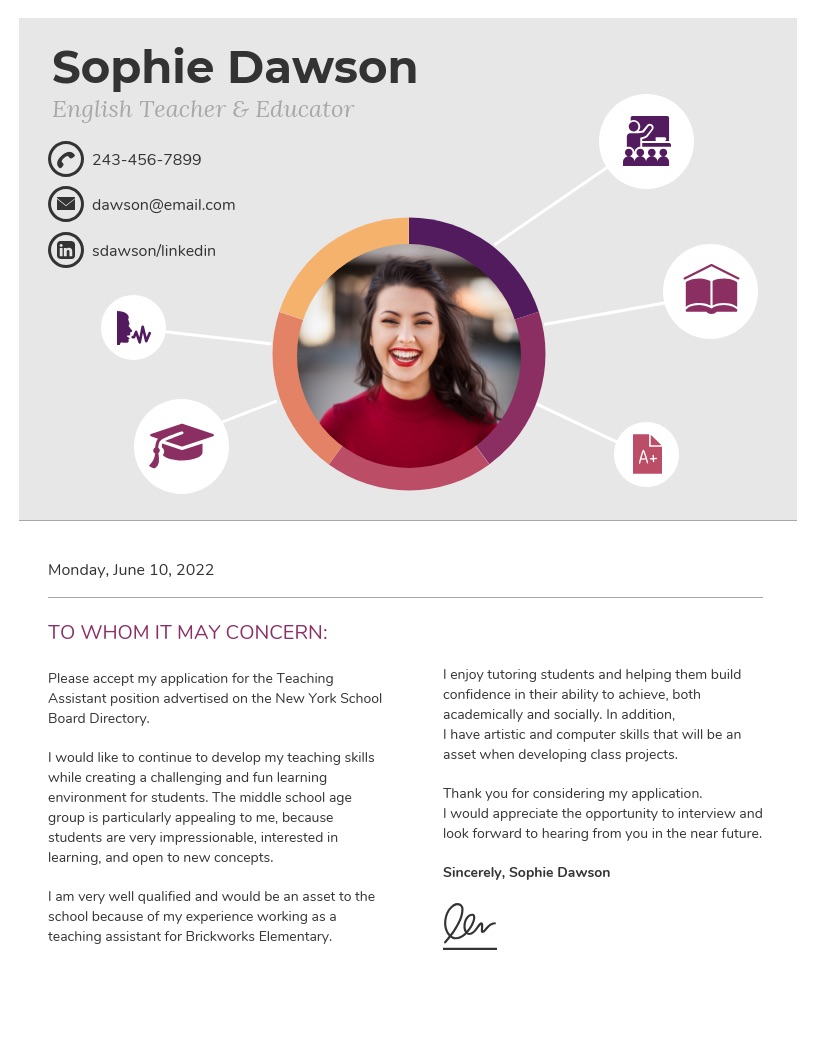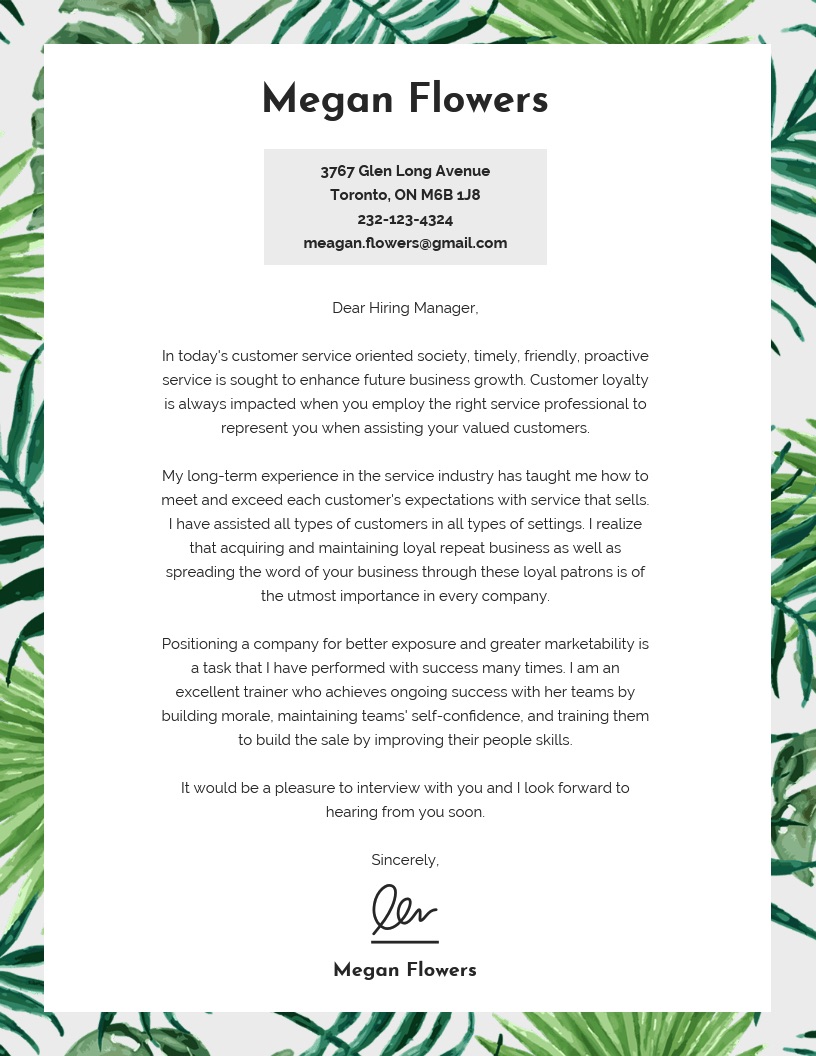Most likely, a cover letter is an employer’s first look at who you are. This includes your qualifications, your goals and also your personality.
That’s a lot to ask of a one page letter! Thankfully, adding a personal brand is a great way to show off your personality.
Build a personal brand by adding a logo, creative header, border or signature to your cover letter and being deliberate about your color choices. If this seems forced to you, think of this as an opportunity to be creative and show off who you are through graphic design.
It’s also about maximizing the impact of that one page letter so that the reader immediately comes away with a favorable impression of who you are and what you can do for their company.
If you’re new to design, an online cover letter maker tool offers templates and drag and drop capability for design newbies. There are also plenty of free templates online.
Let’s get started!
1. Add a personal logo
Creating your own logo might seem like an overwhelming task. But, it can be as easy as writing your name in an interesting font or putting your initials in a shape like a circle. Here’s one example:

Get creative! What shapes or font styles reflect your personality? That said, you’ll want to pick something eye-catching and that you can use in multiple places–say your LinkedIn header, website or online portfolio.
Not sure where to start? Some colors are associated more frequently with certain industries, like green for financial services and blue and gray for education, according to a study on logo styles and colors.
So you might want to use a color associated with your industry. Use a logo maker tool if you need help.
2. Try a creative header
A cover letter header is a great way to make an immediate impression on the reader. You can design your header so that it looks like you’re someone who’s inventive and takes risks. Or someone who’s reliable and competent.
The foundation of your cover letter header may be your logo. Or just stick with a headshot. You can make it look more creative by putting it in a circle frame, like in the example below:

Sophie’s cover letter header also uses bright colors, icons and a large, bold format to say that she’s smart, personable and creative.
Icons quickly tell you that she’s studious and a good communicator. Her headshot and rounded brand fonts makes her look approachable. The reader quickly gets a sense of her personality, without reading anything!
You may be wondering: but I have so much to say in my cover letter! How am I supposed to use a big header and write everything I need to on one page? Take this advice from a top job search strategist:
“Keep your cover letter concise, easy to skim and be sure to connect the dots as to why you meet the important qualifications.”
– Hannah Morgan, Job Search Strategist at CareerSherpa
Your cover letter shouldn’t be an essay. A larger header can force you to be concise and focus on what you can offer the company and how that aligns with their vision–the most important part, by far.
3. Insert a beautiful image
The right photo can add a final touch to your cover letter design. It can fill up any empty space and reinforce your personal branding–whether that’s creative or data-driven.
For example, if you’re applying for a customer experience job, you’ll want to show that you’re a great communicator. Search Unsplash for “communication” to get ideas (their stock photos are free, by the way).
As this expert advises, try to find out where your personal values and the values of your target company align. Are they looking for a team player? An independent type who can work remotely? What image can you use that best sums up this value?
“Try to figure out what they value (this is not hard – a lot of companies share their core values somewhere on their site). Pick which of those core values resonate most with you. Then, tailor your letter to those values. That is: how have you demonstrated that value in your career so far? How would your experience / skill set contribute to that value if you were to work at this company?”
– Claire Suellentrop, Co-Founder and Head of Marketing at Userlist.io
In this cover letter example, Owen uses an image of a minimalist but creative desk to show off his personal aesthetic (and maybe his strong work ethic, too):

Since Owen’s an art director, any hiring manager would definitely want to know if his aesthetic matches the potential company’s. Creativity is key.
As Dennis Yu, the CTO of BlitzMetrics, advises in a podcast on Facebook marketing, perceived authority isn’t built by telling people how good you are at something. It’s about positioning yourself in more subtle ways–like using visuals and colors to do the talking for you.
4. Include a signature
Here’s an easy way to add a personal touch–include your signature at the bottom of your cover letter. It’s simple, but it can make your cover letter just a tiny bit more memorable too.
This cover letter includes a signature. It also includes a couple of other stylistic touches that set Megan apart as creative and inventive. This includes it’s centered text, minimalistic format and bold border:

As for a border, you can use an image that reflects your skills or passions. Use a map if you’re a global jetsetter, for example. Again, Unsplash is a great place to search for image ideas.
Now, you may be wondering: I’ve designed the most beautiful cover letter possible. What about the copy? Take this CEO’s advice:
“When hiring marketers, I look for creativity and powerful copywriting. Empathy…understand the role your prospective employer is hiring for and what good and bad (very important to have why you might not fit) ways you fit in.”
– Derric Haynie, CEO of Vulpine Interactive
In other words, skip the flattering paragraphs about your background. Hone in what the company’s core values (check their About page on their website for ideas) and show how your skill set demonstrates those values.
For example, a core value could be “we own our jobs.” You could mention how you came up with new initiatives and adapted/expanded your role to your past company’s needs.
The takeaway
Most cover letters are pretty boring. Adding a couple of inventive design elements can separate your job application from the pack. Your cover letter isn’t like everyone else’s–and neither are you!


